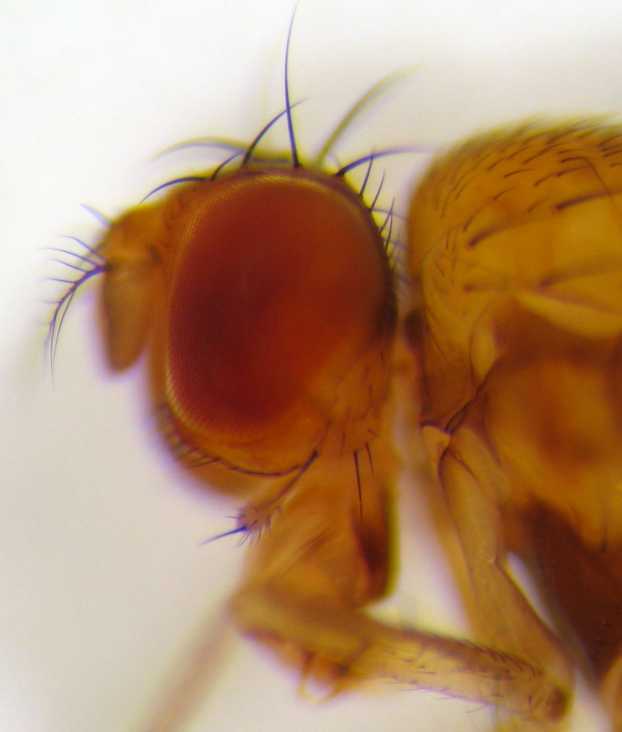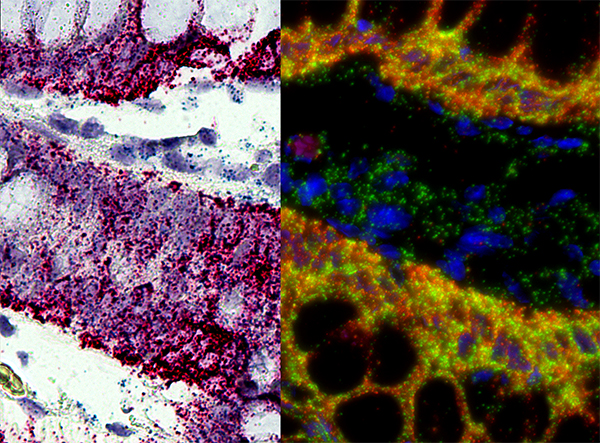|
Or83b Odorant Receptor
Or83b, also known as Orco (short for "odorant receptor co-receptor"), is an odorant receptor and the corresponding gene that encodes it. The odorant receptor Or83b is not exclusively expressed in insects. Though its actual function is still a mystery, the broadly expressed Or83b has been conserved across highly divergent insect populations across 250 million years of evolution. Function There are two contending models for potentially explaining Or83b function. One proposes that it could interact with specific odor stimuli independently of other odorant receptors (ORs). The other proposes that it could act with other ORs to mediate responses to all odors. Or83b mutation disrupts behavioral and electrophysiological responses to many odorants, which supports the second model that OR plays a general rather than specific role in olfaction. When mutating the Or83b gene, larval ''Drosophila'' do not travel towards an area of ethyl acetate, which is an important odorant related to rottin ... [...More Info...] [...Related Items...] OR: [Wikipedia] [Google] [Baidu] |
Odorant Receptor
Olfactory receptors (ORs), also known as odorant receptors, are chemoreceptors expressed in the cell membranes of olfactory receptor neurons and are responsible for the detection of odorants (for example, compounds that have an odor) which give rise to the sense of smell. Activated olfactory receptors trigger nerve impulses which transmit information about odor to the brain. In vertebrates, these receptors are members of the class A rhodopsin-like family of G protein-coupled receptors (GPCRs). The olfactory receptors form the largest multigene family in vertebrates consisting of around 400 genes in humans and 1400 genes in mice. In insects, olfactory receptors are members of an unrelated group of ligand-gated ion channels. Expression In vertebrates, the olfactory receptors are located in both the cilia and synapses of the olfactory sensory neurons and in the epithelium of the human airway. Sperm cells also express odorant receptors, which are thought to be involved in chemo ... [...More Info...] [...Related Items...] OR: [Wikipedia] [Google] [Baidu] |
Function (biology)
In evolutionary biology, function is the reason some object or process occurred in a system that evolved through natural selection. That reason is typically that it achieves some result, such as that chlorophyll helps to capture the energy of sunlight in photosynthesis. Hence, the organism that contains it is more likely to survive and reproduce, in other words the function increases the organism's fitness. A characteristic that assists in evolution is called an adaptation; other characteristics may be non-functional spandrels, though these in turn may later be co-opted by evolution to serve new functions. In biology, function has been defined in many ways. In physiology, it is simply what an organ, tissue, cell or molecule does. In the philosophy of biology, talk of function inevitably suggests some kind of teleological purpose, even though natural selection operates without any goal for the future. All the same, biologists often use teleological language as a shorthan ... [...More Info...] [...Related Items...] OR: [Wikipedia] [Google] [Baidu] |
Odor
An odor (American English) or odour ( Commonwealth English; see spelling differences) is a smell or a scent caused by one or more volatilized chemical compounds generally found in low concentrations that humans and many animals can perceive via their olfactory system. While ''smell'' can refer to pleasant and unpleasant odors, the terms ''scent'', ''aroma'', and ''fragrance'' are usually reserved for pleasant-smelling odors and are frequently used in the food and cosmetic industry to describe floral scents or to refer to perfumes. Odor physiology Sense of smell The perception of odors, or sense of smell, is mediated by the olfactory nerve. The olfactory receptor (OR) cells are neurons present in the olfactory epithelium, which is a small patch of tissue at the back of the nasal cavity. There are millions of olfactory receptor neurons that act as sensory signaling cells. Each neuron has cilia in direct contact with the air. Odorous molecules bind to receptor pro ... [...More Info...] [...Related Items...] OR: [Wikipedia] [Google] [Baidu] |
Mutation
In biology, a mutation is an alteration in the nucleic acid sequence of the genome of an organism, virus, or extrachromosomal DNA. Viral genomes contain either DNA or RNA. Mutations result from errors during DNA or viral replication, mitosis, or meiosis or other types of damage to DNA (such as pyrimidine dimers caused by exposure to ultraviolet radiation), which then may undergo error-prone repair (especially microhomology-mediated end joining), cause an error during other forms of repair, or cause an error during replication ( translesion synthesis). Mutations may also result from substitution, insertion or deletion of segments of DNA due to mobile genetic elements. Mutations may or may not produce detectable changes in the observable characteristics ( phenotype) of an organism. Mutations play a part in both normal and abnormal biological processes including: evolution, cancer, and the development of the immune system, including junctional diversity. Mutati ... [...More Info...] [...Related Items...] OR: [Wikipedia] [Google] [Baidu] |
Electrophysiology
Electrophysiology (from [see the Electron#Etymology, etymology of "electron"]; ; and ) is the branch of physiology that studies the electrical properties of biological cell (biology), cells and tissues. It involves measurements of voltage changes or electric current or manipulations on a wide variety of scales from single ion channel proteins to whole organs like the heart. In neuroscience, it includes measurements of the electrical activity of neurons, and, in particular, action potential activity. Recordings of large-scale electric signals from the nervous system, such as electroencephalography, may also be referred to as electrophysiological recordings. They are useful for electrodiagnostic medicine, electrodiagnosis and monitoring (medicine), monitoring. Definition and scope Classical electrophysiological techniques Principle and mechanisms Electrophysiology is the branch of physiology that pertains broadly to the flow of ions (ion current) in biological tissues and, in p ... [...More Info...] [...Related Items...] OR: [Wikipedia] [Google] [Baidu] |
Odorants
An aroma compound, also known as an odorant, aroma, fragrance, flavoring or flavor, is a chemical compound that has a smell or odor. For an individual chemical or class of chemical compounds to impart a smell or fragrance, it must be sufficiently volatile for transmission via the air to the olfactory system in the upper part of the nose. As examples, various fragrant fruits have diverse aroma compounds, particularly strawberries which are commercially cultivated to have appealing aromas, and contain several hundred aroma compounds. Generally, molecules meeting this specification have molecular weights of less than 310. Flavors affect both the sense of taste and smell, whereas fragrances affect only smell. Flavors tend to be naturally occurring, and the term ''fragrances'' may also apply to synthetic compounds, such as those used in cosmetics. Aroma compounds can naturally be found in various foods, such as fruits and their peels, wine, spices, floral scent, perfumes, frag ... [...More Info...] [...Related Items...] OR: [Wikipedia] [Google] [Baidu] |
Olfaction
The sense of smell, or olfaction, is the special sense through which smells (or odors) are perceived. The sense of smell has many functions, including detecting desirable foods, hazards, and pheromones, and plays a role in taste. In humans, it occurs when an odor binds to a receptor within the nasal cavity, transmitting a signal through the olfactory system. Glomeruli aggregate signals from these receptors and transmit them to the olfactory bulb, where the sensory input will start to interact with parts of the brain responsible for smell identification, memory, and emotion. There are many different things which can interfere with a normal sense of smell, including damage to the nose or smell receptors, anosmia, upper respiratory infections, traumatic brain injury, and neurodegenerative disease. History of study Early scientific study of the sense of smell includes the extensive doctoral dissertation of Eleanor Gamble, published in 1898, which compared olfactory to ... [...More Info...] [...Related Items...] OR: [Wikipedia] [Google] [Baidu] |
Drosophila
''Drosophila'' (), from Ancient Greek δρόσος (''drósos''), meaning "dew", and φίλος (''phílos''), meaning "loving", is a genus of fly, belonging to the family Drosophilidae, whose members are often called "small fruit flies" or pomace flies, vinegar flies, or wine flies, a reference to the characteristic of many species to linger around overripe or rotting fruit. They should not be confused with the Tephritidae, a related family, which are also called fruit flies (sometimes referred to as "true fruit flies"); tephritids feed primarily on unripe or ripe fruit, with many species being regarded as destructive agricultural pests, especially the Mediterranean fruit fly. One species of ''Drosophila'' in particular, ''Drosophila melanogaster'', has been heavily used in research in genetics and is a common model organism in developmental biology. The terms "fruit fly" and "''Drosophila''" are often used synonymously with ''D. melanogaster'' in modern biological literatur ... [...More Info...] [...Related Items...] OR: [Wikipedia] [Google] [Baidu] |
Ethyl Acetate
Ethyl acetate commonly abbreviated EtOAc, ETAC or EA) is the organic compound with the formula , simplified to . This flammable, colorless liquid has a characteristic sweet smell (similar to pear drops) and is used in glues, nail polish removers, and the decaffeination process of tea and coffee. Ethyl acetate is the ester of ethanol and acetic acid; it is manufactured on a large scale for use as a solvent. Production and synthesis Ethyl acetate was first synthesized by the Louis-Léon de Brancas, Count de Lauraguais in 1759 by distilling a mixture of ethanol and acetic acid. In 2004, an estimated 1.3 million tonnes were produced worldwide. The combined annual production in 1985 of Japan, North America, and Europe was about 400,000 tonnes. The global ethyl acetate market was valued at $3.3 billion in 2018. Ethyl acetate is produced in industry mainly via the classic Fischer esterification reaction of ethanol and acetic acid. This mixture converts to the ester in about 65% ... [...More Info...] [...Related Items...] OR: [Wikipedia] [Google] [Baidu] |
Chemoreceptor
A chemoreceptor, also known as chemosensor, is a specialized sensory receptor which transduces a chemical substance ( endogenous or induced) to generate a biological signal. This signal may be in the form of an action potential, if the chemoreceptor is a neuron, or in the form of a neurotransmitter that can activate a nerve fiber if the chemoreceptor is a specialized cell, such as taste receptors, or an internal peripheral chemoreceptor, such as the carotid bodies. In physiology, a chemoreceptor detects changes in the normal environment, such as an increase in blood levels of carbon dioxide (hypercapnia) or a decrease in blood levels of oxygen (hypoxia), and transmits that information to the central nervous system which engages body responses to restore homeostasis. In bacteria, chemoreceptors are essential in the mediation of chemotaxis. Cellular chemoreceptors In prokaryotes Bacteria utilize complex long helical proteins as chemoreceptors, permitting signals to travel lon ... [...More Info...] [...Related Items...] OR: [Wikipedia] [Google] [Baidu] |
In Situ Hybridization
''In situ'' hybridization (ISH) is a type of Hybridisation (molecular biology), hybridization that uses a labeled complementary DNA, RNA or modified nucleic acid strand (i.e., a Hybridization probe, probe) to localize a specific DNA or RNA sequence in a portion or section of tissue (biology), tissue (''in situ'') or if the tissue is small enough (e.g., plant seeds, ''Drosophila'' embryos), in the entire tissue (whole mount ISH), in cells, and in circulating tumor cells (CTCs). This is distinct from immunohistochemistry, which usually localizes proteins in tissue sections. In situ hybridization is used to reveal the location of specific nucleic acid sequences on chromosomes or in tissues, a crucial step for understanding the organization, regulation, and function of genes. The key techniques currently in use include ''in situ'' hybridization to mRNA with oligonucleotide and RNA probes (both radio-labeled and hapten-labeled), analysis with light and electron microscopes, whole mo ... [...More Info...] [...Related Items...] OR: [Wikipedia] [Google] [Baidu] |
Blood-borne Disease
A blood-borne disease is a disease that can be spread through contamination by blood and other body fluids. Blood can contain pathogens of various types, chief among which are microorganisms, like bacteria and parasites, and non-living infectious agents such as viruses. Three blood-borne pathogens in particular, all viruses, are cited as of primary concern to health workers by the CDC-NIOSH: human immunodeficiency virus, hepatitis B, and hepatitis C. Diseases that are not usually transmitted directly by blood contact, but rather by insect or other vector, are more usefully classified as vector-borne disease, even though the causative agent can be found in blood. Vector-borne diseases include West Nile virus, zika fever and malaria. Many blood-borne diseases can also be contracted by other means, including high-risk sexual behavior or intravenous drug use. These diseases have also been identified in sports medicine. Since it is difficult to determine what pathogens any given sa ... [...More Info...] [...Related Items...] OR: [Wikipedia] [Google] [Baidu] |





